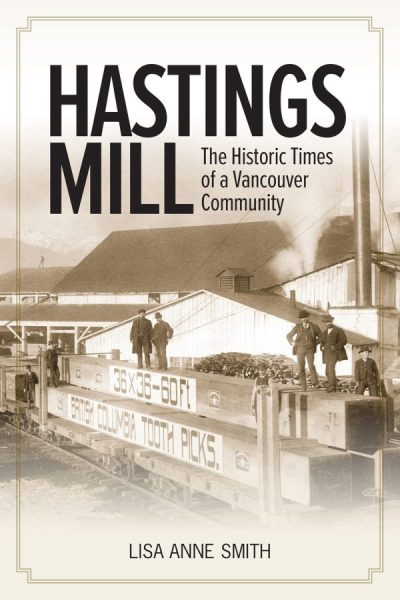
Hastings Mill: The Historic Times of a Vancouver Community
Review By David Brownstein
May 11, 2023
BC Studies no. 217 Spring 2023 | p. 128-130
This is the biography of a building. The Hastings-Mill General-Store and Post-Office was always a centre around which intersecting communities congregated. Here, Lisa Anne Smith revisits the familiar story of the Hastings Mill, providing an updated telling in The Historic Times of A Vancouver Community. This laboriously researched volume, intended for a general audience, is not explicitly united by a single thesis or argument. Rather, it is a series of 26 chapters and three appendices on topics related to the Hastings Mill store. The first 21 chapters circumnavigate Vancouver’s first sawmill, its times and personalities, while the last five detail the mill store’s move to a new location, and its afterlife as a museum. The frequent photos and maps are welcome.
The Hastings Sawmill was Captain Edward Stamp’s third attempt at making money from British Columbia’s forests. The first had been in 1860, on Vancouver Island’s Alberni Inlet, which was scuttled by the Tseshaht. Armed with additional English capital, Stamp tried again, setting his sights instead on Burrard Inlet’s south shore, where he formed the British Columbia and Vancouver Island Spar, Lumber and Sawmill Company. This second try, at a location that would eventually become Stanley Park, was frustrated by uncooperative tides. Finally, in 1865 Stamp tried yet again, further to the east, bordering on the Squamish encampment, K’emk’emláy. This mill was successful at producing lumber for export in 1867.
Smith’s book was a decade in the making. It began with a visit to the Hastings-Store Museum for a lecture by the now late Chuck Davis; that event was transformational, and it inspired Smith “to become involved with Vancouver’s oldest surviving building and its remarkable past” (282). This book is Smith’s most detailed project to date, previously having written other local volumes on Joe Fortes, the Vancouver fire of 1886, and Vancouver’s first nurse, Emily Patterson.
The Historic Times of A Vancouver Community shares much in common with the limited previous literature on Hastings Mill. It also represents a significant update. The Hastings Mill has not seen much scrutiny by academic historians. Indeed, for a previous dedicated work, one must look to UBC Professor-of-Medicine James Morton’s 1977 The Enterprising Mr. Moody, The Bumptuous Captain Stamp: The Lives and Colourful Times of Vancouver’s Lumber Pioneers. That book, also about north shore rival Moodyville, was similarly aimed at a general audience. At the time, George Woodcock complained that Morton had a passion for minor detail, and that Morton became caught up in the genealogical minutiae beloved of local historians. Smith’s narrative maintains that tradition. Morton was also criticized for providing an extensive list of sources, but not individual footnotes. Today, too, Smith follows that convention, a choice that will frustrate the technical reader. Smith does include some footnotes, but not nearly enough to satisfy those seeking to connect her prose back to her sources. In this vein, Smith’s treatment of sources sometimes departs from the original texts. For example, I was excited to read strikingly modern-sounding old-growth conservation concerns, ascribed to 1920s personalities (173). Unfortunately, upon consulting the original text, I was disappointed to learn that the modern meaning had been inserted by the author and was not present in the original. So, for careful wider context and analysis, one must still consult Robert A.J. McDonald’s “Lumber Society on the Industrial Frontier: Burrard Inlet, 1863-1886″ in Labour/Le Travail (1994).
Rather than an analytical, in-depth study of sawmilling, Smith places community at the centre of her book, and this is its primary strength. Smith distinguishes herself in this updated telling, by partially inserting Natives and women back into the story. For instance, there is an eight-page appendix on neighbouring K’emk’emeláy, detailing Indigenous use of flora, communicated with Halkomelem plant names. Several members of Burrard Inlet’s Indigenous communities who frequented the store, both as suppliers and customers, also find a place in the volume. Smith recounts how Chinalset used his giant freight canoe to deliver supplies from the store to the logging camps out at Point Grey, while his wife Qhwy-wat provided the store with cows milk. Further extending insight into local society, chapter 4 “Women of the Mill” recovers female voices by narrating the stories of women Settlers residing in the vicinity of the mill. From Emma Alexander (wife of store manager Richard), to Georgia Sweeney (schoolteacher), Emily Patterson (nurse), and daughter Abbie Patterson (at 15 years old, bride in the first marriage conducted at the mill townsite), readers peek into local women’s lives.
The Hastings Mill introduced industrialization and capitalism to Burrard Inlet, forces that would go on to reshape the surrounding waterfront (and ultimately bring about the mill’s own demise). By the 1920s, the Mill’s prime location was bought by the Vancouver Harbour Board (189). Due to the store’s historical significance, it was offered to the City of Vancouver, provided that the building could be relocated. When the City decided that the store’s preservation was not practical, the local Native Daughters of BC, with a mandate to perpetuate the memory of early BC pioneers, intervened to raise funds to save it. Successful in that goal, the book’s concluding chapters tell of the building’s relocation to Point Grey and ultimate transformation into a museum. This journey is revealing for those interested in how local history societies have changed with time, and their shifting notions of Indigineity. While the mission and basic protocols are still those created in 1919, the organization is now called “Friends of Old Hastings Mill Store Museum” and today people of any gender can participate (265). All royalties from book sales support the Friends, a registered charity. A welcome book for a worthy cause.
Publication Information
Lisa Anne Smith. Hastings Mill: The Historic Times of a Vancouver Community. Ronsdale Press: Vancouver, 2021. 312 pp. $24.95 paper.
